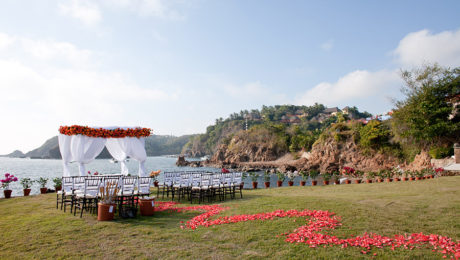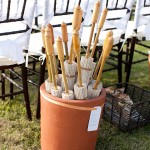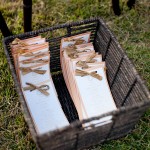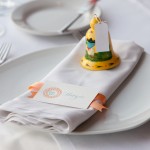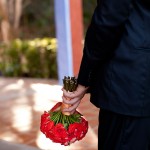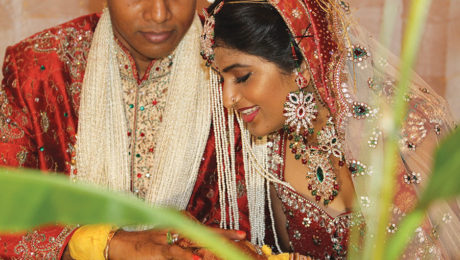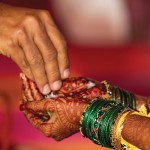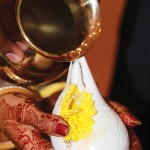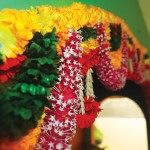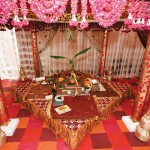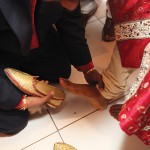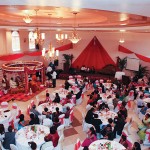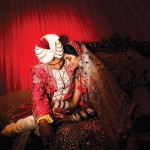Mexican Wedding Fiesta
Photos by Aaron Dieppa Photography
Pre-Wedding Fun
The couple envisioned a wedding weekend that would significantly incorporate their guests, as all 28 were flying to Mexico to witness their marriage. Thara and Aaron prepared welcome bags for each guest with snacks, games, and even a personal newsletter from the couple! The newsletter included an itinerary for the weekend and suggested activities that guests could enjoy while at the resort: snorkeling, tennis, spa, fishing, kayaking, etc. The wedding guests also got a handmade map of the hotel and surrounding area, a Spanish/English page of phrases, sun hats, and little painted wooden turtles to keep by their bedside with a note that said: “In Mexico, these hand-painted wooden figures are believed to keep bad dreams away”.
The day before the wedding, guests were treated to a ‘tequila tasting’. A representative from a major tequila manufacturer joined them at the resort, explained the process of making tequila, and administered the tasting of different varieties.
The Wedding
Venue
Thara and Aaron chose the extraordinarily beautiful outdoors of the El Careyes Resort for their ceremony and reception—the same place where they got engaged.
Theme & Décor
The couple went with a Mexican theme and wanted to incorporate their personal, simple yet elegant style into all the elements of their wedding and reception. They opted for light orange and light blue as their colour scheme, and created an emblem with their initials, “T&A”, which was used on the wedding invitations, welcome bags, wedding program, and other printed items.
Tall, white umbrellas were set up around the cocktail area for shade, and hanging lanterns lent a soft glow to the setting for their dinner reception at the hotel. The evening ambiance was made even more exquisite with a bonfire.
Program
On the morning of the wedding, after breakfast, Aaron—accompanied by his two groomsmen and a few of the other male guests—went to the Polo grounds. They split themselves into two teams and played a friendly game. The women had their own agenda too: after a tear-jerking champagne toast and light breakfast, they joined together for a private outdoor yoga class overlooking the water. The wedding ceremony itself was in the late afternoon, followed by cocktail hour with a live Mariachi band and canapés (appetizers). The reception with dinner, cake, and dancing brought the unforgettable night to a close.
Tradition
Although neither Thara (Toronto-born, of Guyanese parentage) nor Aaron (born and raised in Indiana) is Mexican, they incorporated one special Mexican wedding tradition into their ceremony. Mothers of the bride and groom both wrapped a lasso of orchids around the couple, symbolic of protecting the love that would bind them together for the rest of their lives.
Bridal Ensemble
Thara’s dress, by designer Jim Hjelm, was an all-lace, V-neck, and very low-back number, and her veil was custom-made by designer Sara Gabriel. Her only jewelry was a pair of earrings—that Aaron had gifted her on one Christmas—and her engagement ring.
Flowers
Orange roses lavishly decorated the top of the white-curtained ceremonial structure under which the couple exchanged vows, and potted flowering plants decorated the border of the area. The lasso used in the ceremony was made of orange orchids. Roses featured prominently in the bouquets: Thara’s had red roses (that were actually supposed to be orange!), and her two bridesmaids (her sisters) carried orange roses mixed with an array of tropical flowers.
Cake
In keeping with the Mexican theme, of course, nothing less than a tres leches cake would do—deliciously created by the hotel chef. The cake topper (ordered from etsy.com) was a custom hand-crafted paper representation of Thara and Aaron, dressed as they were on their wedding day (the bride’s favourite detail of the wedding).
Music
The Mariachi band and a solo guitarist provided the Mexican-flavored music during the cocktail hour and dinner, and everyone danced to the couple’s selected playlist at the reception.
Quirky Essentials
The groom and groomsmen wore chili pepper boutonnières (an idea the couple got from a magazine), and bells, parasols and maracas were all keepsakes for the guests. Thara and Aaron hand-crafted name tags for each guest’s place setting at the dinner table, where they also placed a small bell with a note saying that the newlyweds would kiss anytime a bell rang!
Parasols were set up in baskets so that guests could each take one and use it as sun-shade during the ceremony. Pairs of maracas were also placed in baskets so that guests could take them to shake after the ceremony as the couple walked back down the aisle as husband and wife. As a parting gift, the couple gave guests a hand-painted Mexican Christmas tree ornament (Christmas would have been celebrated in two weeks).
Memorable Moments
One moment that really stands out for the couple was having Aaron’s grandfather perform a reading during the ceremony. Aaron’s grandparents were almost 90 at the time, yet still made the trip for the wedding. After the couple’s first dance during the reception, they played their grandparents’ favorite song…and the once-upon-a-time newlyweds danced alone with everyone watching.
- Published in Real Weddings
Memorable Hindu Wedding!
Yogita and Ramiz
“Putting Away” the Bride
The bride wore two outfits, the traditional red sari, and yellow sari, purchased at Arman’s Bridal Fashions in Jackson Heights, New York. Yogita says, “There was all this jewellery, and my skirt alone was twenty-five pounds; my veil was five pounds in itself. So you have to get someone to put it all together.” Michael Salickram, co-founder and art director of Shiv Shakti dance group, helped her to do just that; he put the bride away as they say.
The Wedding
Yogita comes from a very traditional Hindu family, hence culture and rituals are very important to her. “I wanted that…the actual ceremony…to be the focus of the day. I really wanted people to witness our wedding.” The couple loved the style and flair of western weddings and sought to marry that with tradition. Hence, the marriage rituals were witnessed by guests in a banquet setting, with a reception immediately following. Yogita says, “I did not have a home wedding in the traditional way – I had it at the hall. When you’re (a Hindu woman) getting married you can’t leave the house the day before, so I could not go to the hall to see the decorations; I just had to remind myself to breathe.”
Yogita has been dancing Indian classical dance, one of her greatest passions, for the past twenty-five years. She quips that Ramiz does not enjoy Indian dance and movies as much as she does; his passion is football. Thus there was also a merging of personalities at their wedding, reflected in their unique place cards, where those for the “girl’s side” were named after Indian dancers, whilst those for the “boy’s side” were named after football stadia, such as Old Trafford.
The red and gold colour scheme of the jewelled invitations, the first glimpse into the event, was translated throughout the wedding. A jewelled Indian woman appears on both the invitations for Yogita’s guests as well as the place cards, whilst the counterpart male appears for Ramiz’s guests.
Tradition
The bride walked into the mandap with rice in her hands. Rice in general, in the Hindu tradition, symbolizes prosperity and good fortune. Hence rice is also traditionally showered upon the bride in a celebratory manner. Ramiz was greeted by Yogita’s mom as he entered the wedding venue; in fact, he’s not allowed to enter until he’s greeted by her. Yogita’s brother then washed his feet and ensured that he was comfortable. Traditionally, when a guest comes to your home you honour them by washing their feet.
Ramiz then came out to the marriage area, or mandap, where Yogita’s father greeted him; afterwards the bride entered the wedding hall, to the tune of the Indian song, Tujh Mein Rab Dikhta Hai (I see God in You), accompanied by close family members. The song is special to the bride and groom (it’s the song from the first Indian movie they saw together), who in that moment, saw each other for the first time that day, and sat opposite each other. The bride’s parents actively participate in a solemn giving away – the mother places her hand under the bride’s, whilst the father places his under the groom’s; the groom’s other hand is then placed beneath.
The Vows
The wedding vows, or Saptapadi, is thought to be the bringing together of two compatible souls. It involves seven mounds of rice, symbolizing seven steps together, or a journey. The first three mounds symbolize the part of the journey where the bride walks alone; from the fourth mound onward, the couple join hands and walk the rest of the way together. Yogita says, “For me, those vows were transcendental; the actual moment of joining together.”
When ancestors brought tradition – they also brought vows. One such vow, for the bride, was to be punctual in domestic duties, in order to avoid discomfort to her husband. This flummoxed Yogita, who had not heard about this particular vow until the wedding day, and who made it clear to the Pundit that she could not agree to it. She says, “ The Pundit did not know what to say to me at that point, so eventually I agreed to share domestic duties with my husband, and he happily agreed – he was relieved that I agreed to something.”
Memorable Moments
Sometimes, the most memorable moments are unplanned – often being the things that went wrong. Yogita recalls: “It was raining really heavily on the day, just as the barath (the groom and guests) were making their way to the venue, and a tree fell across the road. They were all stuck there, waiting for someone to clear the road. This happened close to where they were building a smelter; there was an alternative, forested road and the guard agreed to let only two cars go through. But Ramiz’s parents were left behind, and the wedding could not start without them; we waited two hours for all our guests to arrive.”
The Days Before
The engagement: In Gujarati tradition, the bride’s family sends gifts and sweets for the groom as well as his family. In this case, the bride’s brother was dispatched with gifts, including fruits, and money, to be presented to the groom. In return, the groom sends the ring.
Mehindi Night: This event was held a few days following the engagement. The bride invited only family and close friends – the people she wanted to feel very connected with. Celebrated Mehindi artist, Varsha Roodal, was at hand to provide intricate designs for guests. The bride’s sister and cousins organized dance rehearsals for this night, as a group among them were actually practicing to perform at the wedding.
Matikur Night: This night follows the Mehindi night. Some friends from Yogita’s dance class performed a dance medley, and Yogita recalls that the aftermath was like a scene from an Indian movie, where everyone just came out in impromptu song and dance – that strangely enough, seemed choreographed.
Laawa night: To celebrate, women and men gather to cook dinner for this night and prepare for the following day. Apart from food preparation, one of the main rituals is the “parching of the laawa.” Laawa (rice paddy), is heated on a flame – the same happens at the groom’s house – and there is a little competition to see who parches the first or most – the saying goes that if the groom’s parches first the bride’s won’t parch, and vice versa.
- Published in Real Weddings

